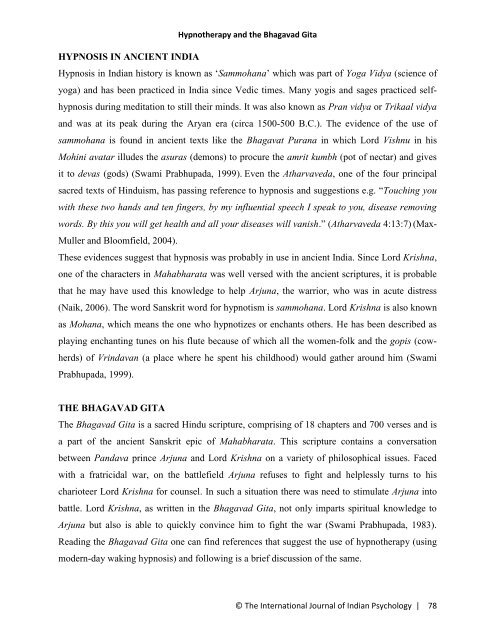Hypnotherapy and the Bhagavad Gita
1RDUWuf
1RDUWuf
Create successful ePaper yourself
Turn your PDF publications into a flip-book with our unique Google optimized e-Paper software.
<strong>Hypno<strong>the</strong>rapy</strong> <strong>and</strong> <strong>the</strong> <strong>Bhagavad</strong> <strong>Gita</strong><br />
HYPNOSIS IN ANCIENT INDIA<br />
Hypnosis in Indian history is known as „Sammohana‟ which was part of Yoga Vidya (science of<br />
yoga) <strong>and</strong> has been practiced in India since Vedic times. Many yogis <strong>and</strong> sages practiced selfhypnosis<br />
during meditation to still <strong>the</strong>ir minds. It was also known as Pran vidya or Trikaal vidya<br />
<strong>and</strong> was at its peak during <strong>the</strong> Aryan era (circa 1500-500 B.C.). The evidence of <strong>the</strong> use of<br />
sammohana is found in ancient texts like <strong>the</strong> Bhagavat Purana in which Lord Vishnu in his<br />
Mohini avatar illudes <strong>the</strong> asuras (demons) to procure <strong>the</strong> amrit kumbh (pot of nectar) <strong>and</strong> gives<br />
it to devas (gods) (Swami Prabhupada, 1999). Even <strong>the</strong> Atharvaveda, one of <strong>the</strong> four principal<br />
sacred texts of Hinduism, has passing reference to hypnosis <strong>and</strong> suggestions e.g. “Touching you<br />
with <strong>the</strong>se two h<strong>and</strong>s <strong>and</strong> ten fingers, by my influential speech I speak to you, disease removing<br />
words. By this you will get health <strong>and</strong> all your diseases will vanish.” (Atharvaveda 4:13:7) (Max-<br />
Muller <strong>and</strong> Bloomfield, 2004).<br />
These evidences suggest that hypnosis was probably in use in ancient India. Since Lord Krishna,<br />
one of <strong>the</strong> characters in Mahabharata was well versed with <strong>the</strong> ancient scriptures, it is probable<br />
that he may have used this knowledge to help Arjuna, <strong>the</strong> warrior, who was in acute distress<br />
(Naik, 2006). The word Sanskrit word for hypnotism is sammohana. Lord Krishna is also known<br />
as Mohana, which means <strong>the</strong> one who hypnotizes or enchants o<strong>the</strong>rs. He has been described as<br />
playing enchanting tunes on his flute because of which all <strong>the</strong> women-folk <strong>and</strong> <strong>the</strong> gopis (cowherds)<br />
of Vrindavan (a place where he spent his childhood) would ga<strong>the</strong>r around him (Swami<br />
Prabhupada, 1999).<br />
THE BHAGAVAD GITA<br />
The <strong>Bhagavad</strong> <strong>Gita</strong> is a sacred Hindu scripture, comprising of 18 chapters <strong>and</strong> 700 verses <strong>and</strong> is<br />
a part of <strong>the</strong> ancient Sanskrit epic of Mahabharata. This scripture contains a conversation<br />
between P<strong>and</strong>ava prince Arjuna <strong>and</strong> Lord Krishna on a variety of philosophical issues. Faced<br />
with a fratricidal war, on <strong>the</strong> battlefield Arjuna refuses to fight <strong>and</strong> helplessly turns to his<br />
charioteer Lord Krishna for counsel. In such a situation <strong>the</strong>re was need to stimulate Arjuna into<br />
battle. Lord Krishna, as written in <strong>the</strong> <strong>Bhagavad</strong> <strong>Gita</strong>, not only imparts spiritual knowledge to<br />
Arjuna but also is able to quickly convince him to fight <strong>the</strong> war (Swami Prabhupada, 1983).<br />
Reading <strong>the</strong> <strong>Bhagavad</strong> <strong>Gita</strong> one can find references that suggest <strong>the</strong> use of hypno<strong>the</strong>rapy (using<br />
modern-day waking hypnosis) <strong>and</strong> following is a brief discussion of <strong>the</strong> same.<br />
© The International Journal of Indian Psychology | 78


